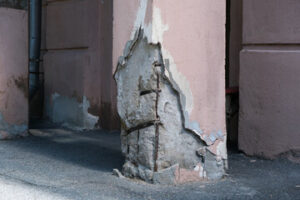Concrete repair can be a complex process. The best solution depends on the type of repair needed and the severity of the deteriorated concrete.

When a structural bond is required, epoxy injection can be used. This requires the shoring of any damaged concrete and good preparation to ensure no unsound concrete remains. Visit https://www.concreterepaireauclaire.com/concrete-leveling to learn more.
There are several different methods for repairing concrete cracks, but the best approach depends on the type of concrete and the severity of the deterioration. For example, wide cracks are a sign of significant instability and may require more extensive repairs. The first step in repairing cracks is to determine what caused them. Then, you must prepare the concrete surface for repair.
This preparation is often overlooked, but it’s crucial for a successful repair. Without it, the concrete repair will likely fail within a few years, necessitating another repair. This is one of the main reasons why it’s important to hire a professional.
Start by opening the cracks to at least 1/4 inch with a chisel. This will allow the new concrete to expand and contract evenly as it matures, preventing further damage. Clean the area around the crack with a pressure washer to remove any dirt, debris or loose concrete. Then, cover the area with a tarp or plastic sheet to prevent dust from escaping during the repair process.
If the cracks are small and confined to the surface, you can use a concrete patching compound. Follow the instructions on the packaging, which will vary depending on the product. Then, trowel the compound into the cracks. For larger cracks, you can use a mortar mix or epoxy-based concrete repair material.
A good concrete repair contractor will take the time to understand what caused the cracks and what caused them to grow. This knowledge will help them recommend the most appropriate repair method. They will also have the skills and equipment necessary to implement that repair, ensuring a high-quality, long-lasting repair.
Some common concrete repair techniques include routing and sealing, carbon fiber wraps, and chemical treatments. These methods will reduce corrosion, stabilize the structure and waterproof the surface.
A professional can also assist with other aspects of concrete repair, such as installing expansion joints and drainage systems. They can add control joints to sidewalks and driveways, install wire mesh reinforcement in slabs, and reinforce structural members. They can even apply seismic bracing to concrete structures.
Repairing Voids
Void repair is a critical part of concrete repair. Void formation is common under concrete slabs, and it can lead to many problems, including cracking, settling, and uneven surfaces. Typically, a void will develop over time, but it can also happen suddenly. When it does, a homeowner should seek professional help to prevent the problem from worsening.
One of the most common ways to repair a void is with polyurethane foam injection. This involves drilling quarter-sized holes into the slab and then injecting a chemical that causes the foam to expand. This method is less invasive than traditional mudjacking, and it doesn’t require much time to cure. Additionally, the hole left by this method is only about the size of a pea (compare that to a full inch from normal mudjacking).
Another way to fix voids in concrete is with sectional slab repair. This is a more involved process that involves identifying the area where the void exists and breaking up the concrete over that area. Then, the void is filled with a sand and cement mixture and properly compacted to ensure that it doesn’t reform in the future.
This method is also more expensive than using mudjacking, but it is usually less invasive and may be more effective for some people. However, it’s still best to contact a professional if a void develops under your concrete. Professionals have access to ground penetrating radar that can quickly locate voids in concrete, and they know how to address them quickly and effectively.
If you find a void under your concrete, it’s important to repair it right away before it gets bigger. Contact a local concrete repair expert and have them inspect the situation. They can recommend the best course of action, and they’ll likely use ground penetrating radar to locate voids and other problems. This is the most accurate and fastest way to identify a void in concrete, and it will prevent the issue from getting worse over time.
Repairing Expansion Joints
Expansion joints are spaces between concrete slabs used to allow room for movement. They relieve stress on structures from seismic events like earthquakes, static load deflection, live load deflection, swaying, thermal expansion and contraction, and high-traffic areas (both pedestrian and vehicular). When these mid-structure separations are damaged or left open, they can lead to concrete cracks and structural damage.
In commercial settings, expansion joints are damaged by heavy trafficking from forklift trucks, AGVs, VNA trucks, trolleys, and other equipment that crush and grind the concrete at the edges of the joint, exposing the reinforcing steel and creating trip hazards and holes. In addition, poor design or construction of the joints can leave them vulnerable to erosion from the freeze-thaw cycle, with water entering and expanding in the porous concrete.
While it is possible to repair concrete expansion joints using a variety of methods, it requires specialized equipment and expertise. Typical methods involve cutting out a gap up to 4’ wide and then rebuilding the concrete layer with normal concrete placement techniques. However, these methods can cost upwards of $20 per linear foot.
A better way to fix the joints is to use a product called Trim-A-Slab, which is made of a rubber-like material that flexes and holds itself in the gaps between slabs. This flexible non-sag caulk filler is resistant to rot, moves with the concrete slab expansion and contraction, is immune to moisture, provides a redundant barrier against weed growth, and is not affected by corrosion of the rebar.
It is also less expensive than a full concrete replacement. For example, repairing a 1’ wide gap with this product can be as low as $15 per linear foot. In comparison, replacing the concrete in a similar area would run upwards of $20 per linear foot. This is why it is important to address deterioration and cracks in concrete expansion joints as soon as they are identified. Properly functioning expansion joints minimize tripping hazards, make forklift travel smoother, and reduce the jarring effects of equipment on the floor and workers. In addition to providing superior safety for your employees, the resulting lower maintenance costs more than offset any initial investment in the expansion joints.
Repairing Damaged Foundations
When a foundation has been damaged by heavy machinery or flooding, it’s important to act quickly. A sagging or sinking foundation can cause major structural damage to the house and create dangerous conditions in the basement. The first step is to figure out what caused the damage and make sure all debris has been removed. It’s also a good idea to use nondestructive evaluation techniques to determine how far the damage extends. These include radar, infrared thermography and impact-echo tests.
Once the damage has been assessed, the next step is to decide what type of repair is needed. Generally, two types of repair methods are available: hydraulic cement and concrete piers. Hydraulic cement is ideal for repairing cracks and voids because it expands as it cures, filling the voids and tightening the cracks. Concrete piers are designed with reinforced concrete and provide stability for foundations to prevent sinking and settlement. They are installed by screwing multiple helical piers into the ground below the foundation until they reach a solid stratum beneath the structure that can support its weight.
To avoid the danger of overheating the soil around your foundation, make sure that helical piers are not driven through saturated soils. They should be installed at a distance from the house to prevent soil moisture from damaging the foundation and to avoid the risk of hydrostatic pressure that could result in sagging or sinking concrete.
It is crucial to choose a contractor with a proven track record. It is also important to educate yourself on repair methods and ask questions. Don’t base your decision on a company’s advertising or cheap prices. Also, look for a company that has its repair methods evaluated by the International Code Council Evaluation Services (ICC-ES).
When deciding whether to repair or replace your foundation, consider your time frame and budget. Replacing concrete is a time-consuming process and requires 28 days to allow the new foundation to set up before you can put any weight on it. Repairing concrete is a faster, more cost-effective process and is a better option for homeowners with limited time or budget constraints.
